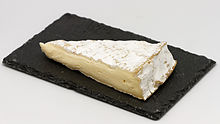Brie
| Brie | |
|---|---|
 |
|
| Country of origin | France |
| Region, town | Seine-et-Marne |
| Town | Brie |
| Source of milk | Cows |
| Pasteurized | By law in the US and Australia, not in most of Europe |
| Texture | Soft-ripened |
| Aging time | generally 5 to 6 weeks |
| Certification | AOC, 1980, for both Brie de Meaux and Brie de Melun |
Brie (/briː/; French: [bʁi]) is a soft cow's-milk cheese named after Brie, the French region from which it originated (roughly corresponding to the modern département of Seine-et-Marne). It is pale in color with a slight grayish tinge under a rind of white mold. The rind is typically eaten, with its flavor depending largely upon the ingredients used and its manufacturing environment.
Brie may be produced from whole or semi-skimmed milk. The curd is obtained by adding rennet to raw milk and warming it to a maximum temperature of 37 °C (99 °F). The cheese is then cast into molds, sometimes with a traditional perforated ladle called a pelle à brie. The 20 cm (8 in) mold is filled with several thin layers of cheese and drained for approximately 18 hours. The cheese is then taken out of the molds, salted, inoculated with cheese culture (Penicillium candidum, Penicillium camemberti) or Brevibacterium linens, and aged in a controlled environment for at least four or five weeks.
If left to mature for longer, typically several months to a year, the cheese becomes stronger in flavor and taste, the pâte drier and darker, and the rind also darker and crumbly, and it is called Brie Noir (French for "black brie"). Around the Île-de-France where brie is made, people enjoy soaking this in café au lait and eating it for breakfast.
...
Wikipedia
